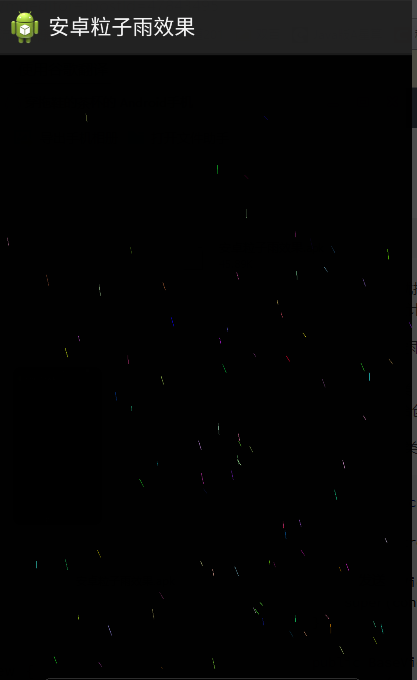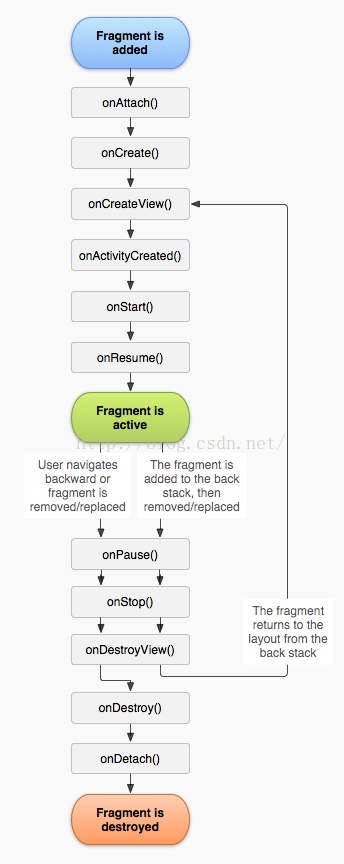編輯:關於Android編程
本文實例介紹了Android實現粒子雨效果的實現過程,分享給大家供大家參考,具體內容如下
先看看效果圖:

具體實現方法:
1.baseview主要是設定雨滴要實現的動作,只是先設定,也就是抽象方法,在子類中實現其方法
2.Rainitems封裝雨滴類
3.Rainitems對雨滴集合創建到面板中,顯示出來,具體實現就是在這個類中
一、baseview封裝類,子類繼承後實現方法即可
public abstract class BaseView extends View {
private control thread;
public BaseView(Context context, AttributeSet attrs) {
super(context, attrs);
}
public BaseView(Context context) {
super(context);
}
//封裝,構造畫面,子類繼承後需要重寫
protected abstract void drawsub(Canvas canvas);
//封裝移動方法,子類繼承後需要重寫
protected abstract void move();
//封裝的初始化方法
protected abstract void init();
@Override
protected final void onDraw(Canvas canvas) {
//啟動線程
if (thread ==null) {
thread = new control();
thread.start();
}else {
drawsub(canvas);
}
}
public class control extends Thread{
@Override
public void run() {
init();
while(true){
move();
//相當於刷新畫布
postInvalidate();
try {
sleep(30);
} catch (InterruptedException e) {
e.printStackTrace();
}
}
}
}
}
二、Rainitem雨點類
public class RainItem {
private int height;
private int width;
private float startX;
private float startY;
private float stopX;
private float stopY;
private float sizeX;
private float sizeY;
private float of = 0.5f;
private Paint paint;
private Random random = new Random();
public RainItem(int height,int width) {
this.height = height;
this.width = width;
init();
}
public void init() {
//startx和y對應的分別是起止位置
sizeX = 1 + random.nextInt(10);
sizeY = 10 + random.nextInt(20);
startX = random.nextInt(width);
startY = random.nextInt(height);
stopX = startX + sizeX;
stopY = startY + sizeY;
of = (float) (0.2 + random.nextFloat());
paint = new Paint();
}
/**
* 繪畫雨滴
* @param canvas
*/
public void draw(Canvas canvas) {
paint.setARGB(255, random.nextInt(255), random.nextInt(255), random.nextInt(255));
canvas.drawLine(startX, startY, stopX, stopY, paint);
}
/**
* 雨滴的移動行為
*/
public void movestep() {
//size*of這個是用來控制速度,所謂的速度就是線條增加的速度
startX += sizeX*of;
stopX += sizeX*of;
startY += sizeY*of;
stopY += sizeY*of;
//如果超出邊界則重新運行
if (startY>height) {
init();
}
}
}
三、Rainplay具體實現的類
public class Rainplay extends BaseView {
List<RainItem> list = new ArrayList<RainItem>();
//控制雨滴的數量
private int num = 80;
public Rainplay(Context context) {
super(context);
}
public Rainplay(Context context, AttributeSet attrs) {
super(context, attrs);
//與xml鏈接起來
TypedArray ta = context.obtainStyledAttributes(attrs, R.styleable.RainView);
num = ta.getInteger(R.styleable.RainView_rainnum,80);
ta.recycle();
}
@Override
protected void drawsub(Canvas canvas) {
for (RainItem item : list) {
item.draw(canvas);
}
}
@Override
protected void move() {
for (RainItem item : list) {
item.movestep();
}
}
/**
* 因為獲取長寬是放在layout之後才可以獲取,所以需要
* 放在線程裡面初始化
*/
@Override
protected void init() {
for (int i = 0; i < num; i++) {
RainItem item = new RainItem(getHeight(), getWidth());
list.add(item);
}
}
}
四、value與xml文件
<?xml version="1.0" encoding="utf-8"?>
<resources>
<declare-styleable name = "RainView">
<attr name="rainnum" format="integer"/>
</declare-styleable>
</resources>
<FrameLayout xmlns:android="http://schemas.android.com/apk/res/android"
xmlns:tools="http://schemas.android.com/tools"
xmlns:an="http://schemas.android.com/apk/res/com.niuli.Rain"
android:layout_width="match_parent"
android:layout_height="match_parent"
>
<com.niuli.Rain.Rainplay
android:layout_width="match_parent"
android:layout_height="match_parent"
android:background="#ff000000"
an:rainnum = "100"/>
</FrameLayout>
希望本文所述對大家學習Android軟件編程有所幫助。
 Android為啥推薦用DialogFragment創建Dialog?
Android為啥推薦用DialogFragment創建Dialog?
前言:這段時候有點忙,因為在趕項目,說忙也都是在敷衍,時間擠擠還是有的,從開始寫博客的那一刻起就應該一直堅持下來,不要三天打魚兩天曬網,上次寫過一個Android進階之(
 Android聯系人中添加歸屬地分組
Android聯系人中添加歸屬地分組
之前重要負責收集聯系人添加歸屬地,公司這兩個智能分組;網上的實現方法很多,有說通過webserver來查詢,但是網絡這種形式不是長遠之道;畢竟服務器不是你自己的,還有
 Android畫板的實現及demo
Android畫板的實現及demo
今天給大家帶來Android畫板功能的簡單實現,以下是效果圖: 以下是關鍵源碼: import android.content.Conte
 Android中使用AsyncTask實現文件下載以及進度更新提示
Android中使用AsyncTask實現文件下載以及進度更新提示
Android提供了一個工具類:AsyncTask,它使創建需要與用戶界面交互的長時間運行的任務變得更簡單。相對Handler來說AsyncTask更輕量級一些,適用於簡